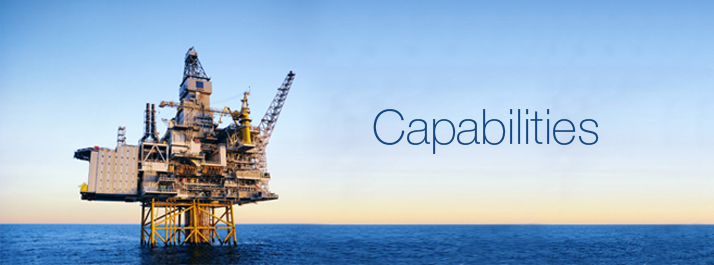

Capabilities
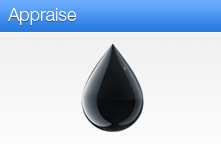
Customer Aims
Establish preliminary scope and business strategy.
Our Services
1. Pre-feasibility screening studies.
2. Business model development.
3. Strategic fit.
Our Business
Bring real world experience into the front-end value adding phases to maximise investment return and underlying confidence.
Typical Analysis
1. Appraise end to end system performance with start-up slug(s) or operational slugging.
2. Assess the key bottlenecks on topsides with different slugging control schemes.
3. Assess the magnitude of slugs during sphering.
Indicative Video

Customer Aims
Establish development options and execution strategy.
Our Services
1. Feasibility studies.
2. Conceptual design.
3. Uncertainty management.
Our Business
Bring real world experience into the front-end value adding phases to maximise investment return and underlying confidence.
Typical Analysis
1. Decide which slug minimisation configuration is optimal for life of field.
2. Assess performance of asset with respect to variation in composition, future tie-backs and low pressure operation studies.
3. Assess performance criteria for existing or new Overpressure Protection Systems (OPPS).
4. Review of control strategies.
Indicative Video
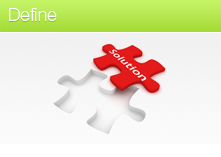
Customer Aims
Finalise scope and execution plan.
Our Services
1. Preliminary Engineering (FEED) validation.
2. Commence FEED.
Our Business
Converts the highest potential value options identified at the SELECT phase into fully defined and successfully executed projects.
Typical Analysis
1. Analyse the performance of current compression/turbo expander system(s) vs. refurbished compression / turbo expander system(s). Assess start-up, shutdown and dynamic state to state behaviour for asset.
2. Rectify surge issues by implementing control, sequencing and process modifications.
3. Single or multiple compressor ramp-up/ramp down studies.
Indicative Video

Customer Aims
Detail and construct asset.
Our Services
1. Preliminary Engineering (FEED) validation.
2. Commence FEED.
Our Business
Converts the highest potential value options identified at the SELECT phase into fully defined and successfully executed projects
Typical Analysis
1. Evaluate asset behaviour during complex cascaded trips.
2. Assess or implement advanced Load Sharing Control System (LSCS) for parallel compression systems.
3. Review pressurised shutdown states and complex segregated blowdown sequence for Thorough Review Safety Case Analysis (TRSCA).
Indicative Video
Coming soon
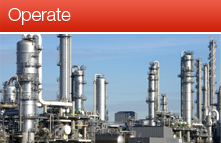
Customer Aims
Operate, maintain and improve asset.
Our Services
1. Brownfield Projects.
2. Operations and maintenance support.
3. Asset management.
4. Detailed engineering.
Our Business
Supports and improves customers assets throughout operating lifecycle.
Typical Analysis
1. Rolling Optimisation and Tuning studies performed to increase asset uptime.
2. Perform “what if” scenarios.
3. Pinpoint control improvements, highlight transient equipment or piping bottlenecks.
4. Provide temporary workarounds to facilitate uptime.
Indicative Video
Coming soon

At RKM PRO ENG we provide solutions to problems that have yet to be discovered by our Clients. We have a wealth of experience and are able to provide high fidelity dynamic models encompassing typically (but not limited to):
Upstream/Midstream
Production Separators, Gas Scrubbers, Heat Exchangers (rigorous model), Air Coolers, Compressors (centrifugal or reciprocating), Pumps (centrifugal or reciprocating), Flare Header, Flare KO Drum, TEG Contactor, TEG Regeneration, Utilities and Produced Water handling equipment.
Downstream
De-methanisers, De-ethanisers, De-propanisers, Debutanisers, Turbo-Expanders and Compressors and Cold Boxes.
Operational State(s) Considered:
- Fluid transients (pressure or flow) for ramp-up, ramp-down, new well with significantly different GORs.
- Slug emulation based on a precise slug map.
- Shutdown (planned, unplanned, pressurised or unpressurised).
- Restart (single/dual/more trains, simultaneous or sequenced from settle out or black start).
- Control system failure.
- Operational mode change (automatic or manual).
- Power or utility failure.
- High pressure, level, temperature or flow trip leading to a part or cascade trip.
- Flare minimisation during start-up
- Any other "what if" scenario.
RKM PRO ENG also provides operator training for existing or new assets.

At RKM PRO ENG we can provide practical solutions to severe slugging in multiphase pipelines in offshore and onshore oil and gas installations. In our experience the challenges faced offshore tend to surpass onshore installations. We believe the key to success is an excellent working knowledge of process control engineering, fluid dynamics, process design and experience. We know that depending on the severity of the problem the optimal solution will reside in one of the three bands indicated below:
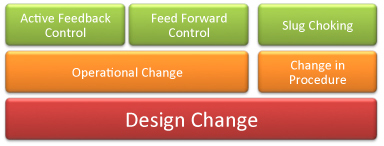
Design Change
For onshore installations this could be achieved by increasing the capacity of the slug handling capacity by installing a new slug catcher. For offshore facilities this could mean the implementation of a new slug suppression device which may be a fast acting control valve or a pre-separation vessel and fast acting gas and liquid control valves.
Operational Change or Change in Procedure
For onshore installations this could mean altering the ramp-up rate, reducing the liquid level in the slug catcher, changing the sphering frequency and the sphere size. For offshore facilities this could mean reducing the opening position of the production choke or operating the pipeline via a start-up choke thereby increasing the upstream pressure and altering the pipeline flow regime.
Active Feedback Control or Feed Forward Control or Slug Choking
This technique is typically used for offshore facilities. The slug control device must be able to recognise the type of slug and negotiate stable topsides production for three types of slugs:
Slug Types
- Riser induced. These are periodic and have a substantial volume. The frequency is usually greater than one hour and they originate due to flowline conditions and flowline-riser geometry. Slug control device(s) can mitigate this type of slugging.
- Transient. The volume and frequency are dependent upon how the slug originated and the flowline characteristics. The origin of these slugs is ramp-up rate or terrain or both. Slug control device(s) can mitigate this type of slugging by controlling the outflow of gas and liquid thereby reducing the periods of gas and liquid surges.
- Hydrodynamic. These slugs are very frequent usually under 15mins and are much smaller typically 25 to 50 times the riser diameter. Slug control device(s) can mitigate against this problem by controlling the outflow of liquid and gas whilst retaining a buffer volume.
Some of the successful strategies are indicated below, for more information please contact us.
Control Strategies
Using a fast acting Production Choke:
- Use cascade control of flowline pressure and volumetric flow to modulate the Production Choke.
- Use cascade control pressure upstream of production choke onto upstream volumetric flow to modulate the Production Choke.
Using a Slug Suppression Device:
- For the gas side use cascade control of vessel pressure onto flow control. For the liquid side use cascade control of level onto flow control.
